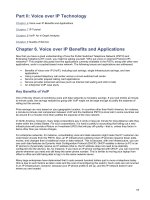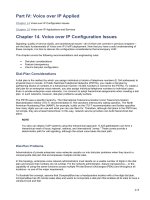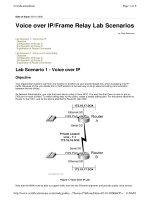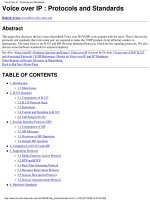Voice over IP Configuration Issues
Bạn đang xem bản rút gọn của tài liệu. Xem và tải ngay bản đầy đủ của tài liệu tại đây (233.74 KB, 5 trang )
Part IV: Voice over IP Applied
Chapter 14 Voice over IP Configuration Issues
Chapter 15
Voice over IP Applications and Services
Chapter 14. Voice over IP Configuration Issues
Signaling, quality of service (QoS), and architectural issues—all of which are covered in previous chapters—
are the basic fundamentals of Voice over IP (VoIP) deployment. Now that you have a solid understanding of
these concepts, it is time to discuss the configuration considerations that accompany VoIP.
This chapter covers the following recommendations and engineering rules:
• Dial-plan considerations
• Feature transparency
• Cisco's dial-plan configuration
Dial-Plan Considerations
A dial plan is the method by which you assign individual or blocks of telephone numbers (E.164 addresses) to
physical lines or circuits. In Public Switched Telephone Networks (PSTNs), you create a dial plan by
partitioning blocks of numbers in a hierarchical manner (10,000 numbers is normal for the PSTN). To create a
dial plan for an enterprise voice network, you also assign individual telephone numbers to individual users.
Even in private enterprise voice networks, it is common to adopt hierarchical assignments when creating a dial
plan. In such networks, however, dial-plan problems usually surface.
The PSTN uses a specific hierarchy. The International Telecommunication Union Telecommunication
Standardization Sector (ITU-T) recommendation E.164 sanctions intercountry calling specifics. The North
American Numbering Plan (NANP), for example, builds on the ITU-T recommendation and further specifies
how many digits you can use and what you can use them for. Therefore, although dial plans in the PSTN are
not simple, they are at least hierarchical. In this way, network service providers can build hierarchical dial
plans.
NOTE
You also can deploy VoIP systems using this hierarchical approach. H.323 gatekeepers can form a
hierarchical mesh of local, regional, national, and international "zones." These zones provide a
deterministic path for call signaling, although the actual voice takes the best path.
Dial-Plan Problems
Administrators of private enterprise voice networks usually run into dial-plan problems when they launch a
companywide dial plan that encompasses multiple remote sites.
In this topology, enterprise voice network administrators must decide on a usable number of digits in the dial
plan and ensure that numbers do not overlap. For the network administrator, feature transparency— or the
capability of using the same functions across multiple Private Branch eXchanges (PBXs) and throughout all
locations—is one of the major requirement.
To illustrate this concept, assume that CompanyBlue has a headquarters location with a five-digit dial plan.
CompanyBlue has 20 remote sales sites and wants to incorporate a dial plan that enables all its sites to have a
cohesive look and feel.
215
CompanyBlue must proceed with the following steps to ensure that its dial plan is consistent:
1. CompanyBlue must analyze corporate and remote sites to ensure that no overlapping digits with a
five-digit plan exist. If overlapping digits do exist, it must decide whether to move to a six- or seven-
digit plan or to give each site its own two-digit code.
NOTE
For some large corporations with thousands of sites, the first three or four digits represent
the store number and the remaining one or two digits represent each extension. Usually,
large corporations with thousands of remote sites use only a few extensions. Referring back
to Chapter 7, "IP Tutorial," this is somewhat akin to subnetting. You must decide what
part of the phone number you should use for addressing the location (if necessary) and
what part you should use for station identification.
2. CompanyBlue must transition the PBX dial plan to translate the new five- or six-digit extensions into
valid E.164 addresses so that the call can still traverse the PSTN.
3. After this initial change is made and the users begin to use the new dial plan, CompanyBlue must
transition to VoIP by simply modifying the Automatic Route Selection (ARS) table.
In some circumstances, enterprises with several remote branches must allocate a large number of digits to
meet the needs of all possible users. Such enterprises simplify their dial plan by implementing a two-stage
dialing procedure.
With two-stage dialing, the caller can dial an access code (similar to using a calling card) that routes him or her
to a specific place in the network. The caller is then presented with a second dial tone, at which point he or she
can dial the actual number to be called. Two-stage dialing offers two main advantages: the remote PBX's dial
plan can be simple, and the network does not need to have a dial-plan outlining the entire network's dial plan.
Instead, the network uses a group of access codes, which map to remote switching points.
The limitations of such an approach are that users must follow a two-step procedure, and they must wait for
the network to properly prompt them for additional inputs. Despite these limitations, however, private
enterprise networks implement two-stage dialing for three main reasons: if they experienced rapid growth, if
they merged with another corporation, or if they acquired another corporation that uses another type of PBX
technology.
Cisco's VoIP implementation enables both single- and two-stage dial plans. Using a single-stage dial plan
(also known as a translational plan) generally requires that users not change their dialing habits. If a company
did not have a dial-plan architecture in the past, imposing a VoIP architecture can introduce some challenges,
such as number-overlapping and a lack of call-routing features.
These problems are not necessarily due to VoIP, but they are exacerbated by the fact that no one at
CompanyBlue put together a cohesive dial plan in the past that would sustain the company if its branches and
main offices were on one central dial plan.
VoIP supports two-stage dialing, but when you use this plan you must be careful for the following reasons:
• You can lose Dual-Tone Multi-Frequency (DTMF) tones as they traverse the Internet Protocol (IP)
network if you use inappropriate encodings. Coding a voice stream—carried over a Real-Time
Transport Protocol (RTP) and through alternative methods—within a signaling path (such as H.245)
enables the transport of DTMF inputs on the network.
• Tandem encodings (dual compressions), which reduce call quality, can now occur due to poor network
planning.
• Multiple digital-to-analog (D/A) conversions can occur, which also reduce call quality.
216
Packet loss is common when using an IP network. If the DTMF tone is carried in a User Datagram Protocol
(UDP) stream, however, the packet or tone can be lost or improperly ordered, which causes the wrong
sequence of digits to be dialed.
If the VoIP provider uses DTMF relay, which enables DTMF tones to be carried in the Transmission Control
Protocol (TCP), the DTMF carriage is just as reliable as the PSTN. Cisco IOS system software supports this
feature. The Cisco IOS command-line interface (CLI) is as follows:
dtmf-relay H245-signal
Features in the PSTN are based mainly on Signaling System 7 (SS7) and the applications built on top of it. To
transparently transport and tunnel features across multiple networks, SS7 must be supported as the
mandatory baseline interface.
This command is configured on the VoIP dial-peer (which is defined later in this chapter).
If no single entity controls the voice and data network, however, it is possible in single- and two-stage dialing to
have multiple compression cycles, which affect voice quality. You must take great care to make sure that
tandem encodings do not occur, as you cannot improve such encodings.
Multiple D/A conversions also can affect voice quality. Where D/A conversions really rear their head, however,
is when modems or some other data transmission over voice is handled. When using a 56-kbps modem, for
example, you can have only one D/A conversion (at residential facilities).
Feature Transparency
Switching from time-division multiplexing (TDM) voice networks to packet-based voice solutions also requires
that you move and support existing applications and functionality in a similar manner.
Often, many PBXs have proprietary signaling methods that currently have no way to move onto IP. This makes
it difficult to have a cost-effective VoIP network that offers limited features. The reason this makes VoIP
networks difficult is because of the proprietary nature of inter-PBX signaling protocols. Often, these proprietary
signaling methods cannot be carried across a VoIP network.
In an attempt to provide some interoperability between PBXs and vendors using digital signaling, the ETSI
Q.Sig standard was developed. This standard is based on the Q.931 signaling stack, but it contains extensions
that enable additional signaling information to be passed between the PBXs.
Q.Sig is a standards-based protocol that enables different brands of PBXs, as well as different networks, to
interoperate. Cisco makes Q.Sig available on its VoIP gateways and can complete Q.sig calls, as well as make
a Q.Sig tunnel between multiple PBXs. This enables enterprise customers to do the following:
• Achieve a feature-rich, cohesive telephony network
• Integrate different vendors' PBXs throughout their network
Enterprise customers who are either unwilling to or cannot upgrade to Q.Sig can have a telephony network
with only basic voice calls. Often, the cost savings and ability to use new IP-enabled applications are enough
to encourage enterprise telephony customers to move to this new network.
PSTN Feature Transparency
Chapter 13, "Virtual Switch Controller"
discusses ways in which these
features can be carried through an IP network.
The H.323 protocol suite was developed assuming Q.931 (Integrated Services Digital Network [ISDN])
interfaces on the voice gateways. The protocol suite has no transparent mechanism to carry and tunnel SS7
messages, including Intelligent Network (IN)-based protocols.
217
Cisco, however, has an SS7 solution that uses H.323, but feature transparency is still not available.
Cisco's Dial-Plan Implementation
This section takes a look at the basics of setting up a Cisco VoIP gateway dial plan.
A fundamental VoIP network must have the following features:
• Local dial-peers to map phone numbers to a physical port
• Network dial-peers to map phone numbers to an IP address
• The ability to strip and add digits
• Number expansion
A dial-peer enables all these basic features. Both a concept and a command, a dial-peer exists in two forms:
as local (PSTN) and as network (VoIP) dial-peers. A prefix command adds digits before the telephone
number is sent out of a local dial-peer. To route a call more efficiently, network managers can add, replace, or
reduce the number of dialed digits, a procedure called number expansion. This procedure also enables
overlapping dial plans to coexist.
Local dial-peers strip all digits matching a specific substring noted in the destination-pattern command.
The dial-peer in Figure 14-1
shows a possible configuration of a simple VoIP network.
Figure 14-1. Cisco Dial-Plan Configuration
Figure 14-1
shows that dial-peer 5 is a local peer, denoted by the pots tag. Figure 14-1 also shows that
port 1/0/0 on Router Ren is mapped to the phone number "1408."
Router Stimpy has a network peer, denoted by the voip tag, which maps the phone number "1408—." to an
IP address. The periods act as wildcards; in this scenario, seven periods tell the phone to wait until 1408 plus
seven more digits are received before attempting to complete the call.
Explained slightly differently, if the voice gateway receives 1408 plus seven digits, it matches that dial-peer
statement and attempts to connect to the session target.
If a user at extension 1000 calls 14085551212, dial-peer 408 on Stimpy places an H.323 call to Ren. Ren
matches the incoming number to dial-peer 5 pots. Because all digits that match are stripped, only the
digits 5551212 are sent to the PSTN. If, for some reason, 1408 needs to remain on the outbound call, you can
use the prefix command to add 1408 back into the outbound digits.
218
Another possibility is to use two-stage dialing. Figure 14-2 shows the changes to the dial plan when two-
stage dialing is implemented.
Figure 14-2. Cisco's Two-Stage Dialing Configuration
Figure 14-2
shows that wildcards are removed from the Stimpy router. Because the Ren router strips all the
digits based on dial-peer voice 5 pots, only a secondary dial tone is offered back to the user at
extension 1000 on router Stimpy. This enables the user at extension 1000 to dial any location because the dial
plan on either router is no longer used.
The following features also are available on Cisco routers:
• Hunt groups—Enable the voice gateway to hunt through dial-peers to ensure delivery of a phone call
to a valid IP gateway.
• Call failover—Enables an IP call to be routed to a different location if the first IP destination is
unreachable.
• Busy out—Enables the gateway to set the physical voice-signaling port to "busy" when network
congestion or network failure occurs.
• Trunking—Enables two VoIP gateways to act as a tie-line (both digital tie-lines and analog tie-lines are
supported).
Summary
Although this chapter did not include all the information you need to configure a large-scale VoIP network, it
did cover the basics of Cisco IOS configuration for VoIP. It also explained the various components a network
administrator must consider before designing and deploying a VoIP network, including dial-plan
considerations, such as single- and two-stage dialing, and their ramifications on voice dialing plans.
This chapter also covered ways in which single- and two-stage dialing affect users, and it provided details on
feature transparency. With a move to VoIP, it is important to determine whether any of the features you rely
upon today are transparently passed across this new VoIP network.
The chapter concluded with information on ways in which Cisco uses dial-peers to map IP addresses and
physical interfaces to phone numbers. This technique provides a great deal of flexibility to network
administrators, as it enables them to create whatever type of dial plan best fits their user base.
219









